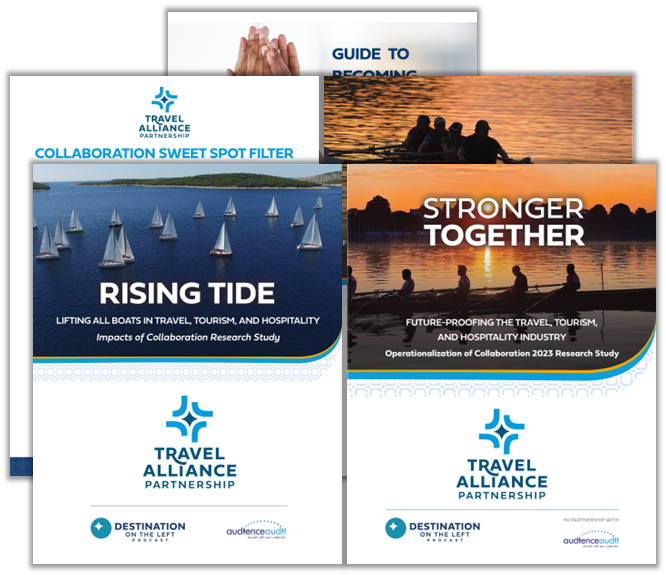4 Common Types of Group Tours
When you see a big motorcoach cruising down the highway, do you ever wonder who’s inside? The answer: just about anyone. Group tours attract all kinds of travelers—from solo adventurers and retirees to student groups, corporate teams, and more. Each coach carries its own story, which is what makes this part of the travel industry so dynamic and exciting.
So, what exactly is a group tour? It’s travel designed for people who want to explore as part of a community—without the stress of planning. Group tours typically include transportation, accommodations, curated activities, and the support of a tour guide or group leader to keep things running smoothly. These tours can be anything from day trips to multi-day journeys, visiting cultural sites, scenic destinations, concerts, and sporting events. Groups might include 10 people or 100, or anything in between.
What does it take to attract a group tour to your destination? That depends on who’s in the group. Here are four common types of group tours—and what they’re looking for.

Senior Group Tours
Many retirees enjoy this type of vacation. It’s ideal for people who love to travel but don’t want to travel alone. They want to meet new people with common interests and have free time during the week. As many retirees are on a fixed income, travel during off-peak time is more economical.
What Destinations Need for Senior Groups
Tour operators who specialize in senior tours take extra care to ensure every destination is accessible and comfortable for this demographic. This can include accommodations for limited mobility, minimal walking, and visits to places that are both engaging and appropriate for older travelers. Senior tours often focus on historic and cultural sites, as well as unique destinations that offer meaningful and enriching experiences.
- Destination/Attraction Example: Schimpff’s Confectionery, the nation’s oldest continually operated family-owned candy store in SoIN (Southern Indiana)
- Tour Operator Example: AmaWaterways River Cruise to Burgundy and Provence with Atlantic Tours
What’s on the Itinerary:
Itineraries are designed with a slower pace, and local guides (called step-on guides) often join the ride to share fascinating stories and enrich the journey with meaningful context. From historic landmarks to unique cultural experiences, senior group travel is all about making lifelong memories—together.
Adventure Group Tours
For those who like to get their adrenaline flowing, adventure group tours are the perfect fit. This segment of group travel is one that has increased significantly in recent years. As more people want to be outdoors and have unique experiences, these tours offer a thrilling way to explore. Also, these groups are often smaller in nature, giving travelers the comfort of a more intimate group while still enjoying the camaraderie and convenience that group travel provides.
While adventure group tours attract a range of ages, they typically include travelers between 30-50 people. The benefit for these thrill-seekers is the chance to explore places they may not discover or be able to navigate on their own. For those who enjoy stepping out of their comfort zone, what better way than placing your trust in expert guides and embarking on an unforgettable journey to unfamiliar destinations? This type of travel experience fosters a camaraderie unlike any other. There’s a unique bond formed when you’re hiking a rugged trail, rafting a rapid river, or zip-lining through the trees.
What Destinations Need for Adventure Groups
These tours could include hiking, kayaking, white water rafting, zip-lining or other similar adventure experiences.
- Destination/Attraction Example: Adventure Calls Outfitters in Letchworth State Park
- Tour Operator Example: Utah’s Mighty Five Tour with Southwest Adenture Tours
What’s on the Itinerary: In addition to adrenaline-pumping activities, adventure tour itineraries often include time to enjoy local cuisine, relax with regional amenities, and soak in the culture. Built-in free time and opportunities to rest ensure that the experience is not only exciting, but also restorative and well-rounded.
Sports Group Tours
Sports fans are some of the most passionate and expressive travelers around, making these types of tours great for those who love watching sporting events but don’t want the hassle. Tour companies offering this type of travel experience typically have more buying options than a single person would because they are guaranteeing purchase of many tickets. This allows them access to highly sought-after seating that may not be available to the general public. These tours may include going to a big game like the Super Bowl or World Series or attending different games over several days. Avid sports fans who want to savor the game without the details will enjoy this type of travel from start to finish.
What Destinations Need for Sports Groups
Sports stadiums and local sports teams and other sporting attractions that offer a mix of live events, interactive experiences, and attractions; celebrating the spirit of sports both on and off the field.
- Destination/Attraction Example: Baseball Hall of Fame in Cooperstown, NY
- Tour Operator Example: Baseball All-Star Game Tour with Sports Travel & Tours
What’s on the Itinerary: Beyond attending games, sports fans also enjoy experiences like sports-themed dining, brewery tours, and visits to iconic stadiums or sports museums. These activities add depth to the trip and create a well-rounded itinerary that caters to their passion for the game—even off the field.
Student Group Tours
Student tours are a vibrant and important part of the group travel market. They give young travelers the chance to explore new places while also learning and growing beyond the classroom. These tours generally fall into four main categories:
- Performance – School performance groups often include chorus, band, and orchestra students. These tours combine travel with opportunities to perform at large public venues. Students also enjoy recreation and free time, which allows them to bond with their peers, explore exciting destinations, and create unforgettable memories together.
- Sports – Sports tours are designed for athletic teams from schools or community groups. They revolve around traveling to tournaments across the country. While competition is the central focus, these trips often weave in sightseeing and recreation, giving students the chance to experience fun moments off the playing field.
- Educational – Educational tours connect directly to classroom curriculum. A history class, for example, may take a multi-day trip to important historic sites. These journeys make learning tangible, immersive, and memorable. Even with an academic focus, itineraries include time for exploration and fun, ensuring the experience feels both engaging and well-rounded.
- Recreational – Recreational tours focus on fun and celebration, often serving as a “last hurrah” for graduating seniors. These trips usually span three or four days and visit popular destinations such as New York City, Disney World, or beach resorts. The emphasis is on enjoyment, entertainment, and shared activities that let students relax, celebrate their accomplishments, and enjoy time together.
What Destinations Need for Student Groups
A mix of performance venues, recreational attractions, and group-friendly accommodations makes a destination stand out as student-tour ready.
- Destination/Attraction Example: Shopping and entertainment center Destiny USA in Syracuse, NY, provides a fun and safe environment for students to enjoy their free time.
- Tour Operator Example: This educational tour to Germany and Lutherland with Ed-Ventures
What’s on the Itinerary: Visits to historical sites and educational attractions that align with curriculum, and other youth-friendly attractions and restaurants.
Learn More About Group Tours and Travel Trade
The travel trade market is rich with opportunity, and there’s lots to learn. As specialists in the travel trade market, we want you to know as much as you can about group tours. Explore these related topics:
- Building Solid Relationships with Tour Operators
- Group Travel Trends: The Evolution of Group Travel
- Partnering with Travel Advisors to Grow Group Travel
Already group friendly? Connect with TAP Tour Operators through our TAP Membership programs, and annual TAP Dance conference.
Interested in becoming group friendly? Let’s chat! From destination assessments to travel trade education and done-for-you services, our team can help you get into the market.
Author
Related Posts
Second Cities, First Choice: Why Groups Are Going Off the Beaten Path in 2025
Big-name cities often steal the spotlight, but sometimes the most rewarding experiences come from the road less traveled. Second cities, those vibrant yet lesser-known destinations…
Tourism Marketing: A Collaborative Approach
Promoting a destination involves celebrating its unique attractions, culture, and experiences. But when different regions join forces, they create something more powerful together than they…
